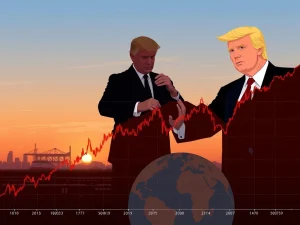US-EU Trade Deal: Navigating Crucial 15% Tariffs to Avert Global Economic Shock

Even in the fast-paced world of cryptocurrency and digital assets, the stability of traditional global markets plays a pivotal role. Major geopolitical and economic shifts, like the recent US-EU trade deal, can ripple through every sector, influencing investment climates and market sentiment. This significant agreement, reached on July 27, 2025, aims to prevent a larger trade conflict by implementing a targeted 15% tariff on specific key sectors. While not directly about crypto, understanding these foundational economic shifts is crucial for any informed investor.
Understanding the Crucial US-EU Trade Deal
The United States and the European Union have successfully forged a preliminary trade agreement, a move designed to de-escalate brewing tensions and prevent a broader economic confrontation. This deal, confirmed by multiple reputable news agencies, sees a uniform 15% tariff applied to several vital industries. These include:
- Pharmaceuticals: Essential for global health and a major economic driver.
- Semiconductors: The backbone of modern technology, from consumer electronics to advanced computing.
- Wine: A significant export for many EU nations, especially France and Italy.
- Automobiles: A cornerstone of both the U.S. and EU economies, with complex supply chains.
This agreement represents a critical compromise. Initially, there were discussions of much higher tariffs, with President Donald Trump’s administration having previously threatened duties as high as 30%. The EU, naturally, resisted such steep import costs. The final 15% rate is a middle ground, designed to stabilize transatlantic trade amidst ongoing geopolitical uncertainties. While most EU goods entering the U.S. will face this rate, certain sectors like aviation and specific medical devices have received limited exemptions.
The Compromise: How Trade Tariffs Reshaped Negotiations
The journey to this US-EU trade deal has been long and complex, marked by previous trade disputes and evolving geopolitical landscapes. A key aspect of this resolution is the significant reduction in proposed EU auto tariffs, which were initially considered for a staggering 30% but settled at 15%. This signals a deliberate shift towards more moderate trade barriers compared to the heated disputes seen in 2018.
Beyond tariffs, the agreement also touches upon broader strategic realignments. The EU’s import of U.S. energy is valued at a substantial $750 billion, highlighting a strategic pivot away from traditional energy sources, particularly Russia. Concurrently, U.S. investments in the EU are projected to increase by $600 billion, further cementing the economic ties between the two blocs. These figures underscore a concerted effort to strengthen transatlantic economic interdependence, which carries implications for global energy markets and investment flows.
Unpacking the Global Economic Impact of the New Agreement
The ramifications of this new international trade agreement are far-reaching, with significant projections from economic forecasting models. The Observatory of Economic Complexity (OEC) has provided a detailed forecast, indicating substantial shifts in global trade dynamics over the coming years. Here’s a snapshot of their predictions:
| Trade Flow | 2022–2024 Average | 2027 Forecast | Projected Change |
|---|---|---|---|
| Global Exports to U.S. | $5.83 Trillion (estimated) | $3.15 Trillion | 46% decline ($2.68 Trillion drop) |
| U.S. Exports to World | $1.42 Trillion (estimated) | $1.59 Trillion | 12% rise |
This forecast suggests a significant rebalancing of trade. While global exports to the U.S. are expected to see a sharp decline, U.S. exports to the rest of the world are projected to grow. Within the EU, Germany, the UK, and France are anticipated to be the primary beneficiaries. For instance, Germany’s exports to the U.S. are projected to grow from $133 billion in 2023 to $149 billion by 2027. However, this growth rate is slower than the $155 billion projected without the tariffs, indicating that while beneficial, the tariffs do temper the potential for even greater expansion.
Perhaps one of the most striking predictions concerns China. Its exports to the U.S. are forecast to fall by a substantial $485 billion. This significant reduction is expected to trigger a redirection of trade, with China likely increasing its trade flows toward other nations such as Russia, Vietnam, and Saudi Arabia. This shift could have profound geopolitical and economic implications, reshaping existing trade alliances and fostering new ones.
Navigating Potential Supply Chain Disruptions and Industry Shifts
The imposition of trade tariffs inevitably introduces new challenges, particularly for global supply chains. Several major companies, with significant stakes in EU-to-U.S. trade, are expected to feel the direct impact. Companies like IKEA, Southern Glazer’s Wine and Spirits, Continental Tire, and Bosch collectively account for a notable 21% of trade between the EU and the U.S. As a result, European exports of goods such as furniture, rubber tires, and wine are likely to face reduced demand in the U.S. market due to the increased cost.
Logistics experts have voiced concerns about the cumulative effect of these tariffs. They warn that layered tariffs will invariably increase costs for shippers, a burden that will likely be passed on to consumers. This is particularly true for high-value goods like specialized machinery and aerospace components. To illustrate, a machinery shipment valued at $300,000 could incur an additional $90,000 in tariffs, making such trade significantly less attractive and potentially deterring businesses from engaging in these transactions.
Retailers in the U.S. have also expressed apprehension, fearing a reduction in product diversity on their shelves as importers become more selective about which goods to bring in under the new tariff structure. While the agreement also outlines provisions for energy and defense, specific details regarding these critical sectors were not extensively detailed in the initial reports.
What This International Trade Agreement Means for the Future
The immediate market reactions to the US-EU trade deal were relatively subdued, with equities and commodities showing limited immediate volatility. This might suggest that the market had already priced in some form of agreement or that the 15% tariff rate was seen as a manageable outcome. Political figures, such as Germany’s Friedrich Merz and the Netherlands’ Dick Schoof, lauded the measures, emphasizing their role in securing economic stability and preventing a larger global economic shock.
However, the deal is not without its critics. While praised for averting a major trade war, concerns persist regarding its potential to cause supply chain disruptions and increase consumer costs in the long run. Analysts note that the 15% rate strikes a delicate balance: it satisfies some of President Trump’s protectionist objectives by keeping tariffs higher than the previous 10% rate, while simultaneously allowing the EU to maintain crucial market access, thereby avoiding the more damaging 30% proposal. This nuanced outcome suggests a pragmatic approach to complex trade relations, seeking stability over absolute gains for either side.
Summary: A Path to Stability Amidst Trade Evolution
The preliminary US-EU trade deal, with its 15% tariffs on key sectors, marks a pivotal moment in transatlantic relations. It successfully navigates the immediate threat of a broader trade conflict, offering a framework for economic stability. While it promises shifts in global trade flows, benefiting some nations and rerouting others, it also introduces challenges for industries and supply chains. This agreement reflects a cautious yet strategic approach to international trade, balancing protectionist sentiments with the imperative of maintaining robust economic ties. Its long-term effects will continue to unfold, shaping the landscape of global commerce for years to come.
Frequently Asked Questions (FAQs)
What are the main terms of the US-EU trade deal?
The core of the deal, reached on July 27, 2025, involves imposing a 15% tariff on specific key sectors including pharmaceuticals, semiconductors, wine, and automobiles. It aims to avert a broader trade conflict, acting as a compromise between initial higher tariff threats and EU resistance. Limited exemptions apply to aviation and certain medical devices.
Which sectors are most affected by the new trade tariffs?
The sectors most directly affected by the 15% trade tariffs are pharmaceuticals, semiconductors, wine, and automobiles. Companies involved in the export of furniture, rubber tires, and wine from the EU to the U.S. are also expected to face reduced demand due to increased costs.
How will this deal impact global trade flows?
According to The Observatory of Economic Complexity (OEC), global exports to the U.S. are forecast to decline by 46% ($2.68 trillion) by 2027, while U.S. exports to the world are projected to rise by 12% ($1.59 trillion). China’s exports to the U.S. are expected to fall significantly, leading to trade redirection towards countries like Russia, Vietnam, and Saudi Arabia.
What are the potential challenges for businesses due to this international trade agreement?
Businesses face increased costs, particularly for high-value goods, due to layered tariffs. Logistics experts warn of higher shipping expenses. Retailers are concerned about reduced product diversity in U.S. markets. Industries reliant on EU-to-U.S. trade, such as furniture, tires, and wine, may see decreased demand.
Was the US-EU trade deal considered a success by all parties?
The deal was largely praised for securing economic stability and preventing a major global economic shock, with officials from Germany and the Netherlands expressing approval. However, it also faces criticism for potential supply chain disruptions and increased costs, indicating a mixed reception that balances protectionist goals with market access needs.
How does this deal compare to previous trade disputes?
This deal represents a shift toward more moderate barriers compared to the intense trade disputes of 2018. While the 15% tariff is higher than the previous 10% rate, it successfully avoids the more aggressive 30% tariffs initially proposed, indicating a more pragmatic and compromising approach to transatlantic trade relations.









